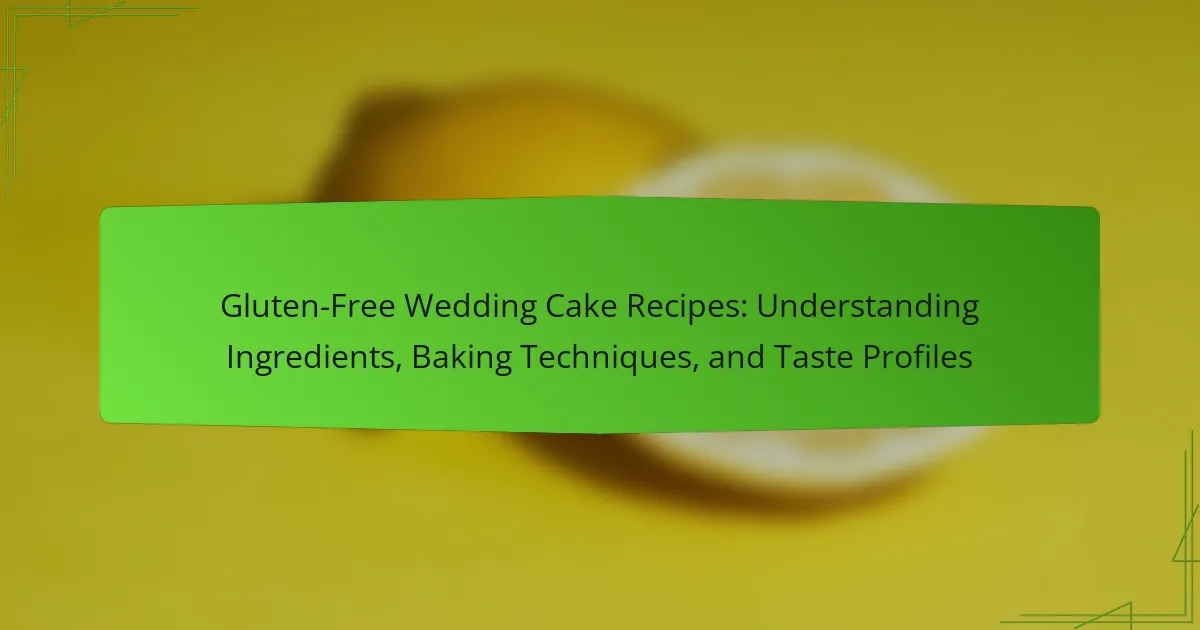
What are Gluten-Free Wedding Cake Recipes?
Gluten-free wedding cake recipes are cake recipes specifically designed without gluten-containing ingredients. These recipes use alternative flours such as almond, coconut, or rice flour. They often incorporate gluten-free baking powder to achieve the desired rise. Many gluten-free recipes utilize eggs to provide structure and moisture. Sweeteners like honey or maple syrup are common in these cakes. Flavorings such as vanilla or citrus zest enhance the taste profile. These cakes can be layered and decorated just like traditional wedding cakes. Gluten-free wedding cakes cater to individuals with celiac disease or gluten sensitivity.
How do gluten-free wedding cakes differ from traditional cakes?
Gluten-free wedding cakes differ from traditional cakes primarily in their ingredients. Traditional cakes typically use wheat flour, which contains gluten. Gluten-free cakes substitute wheat flour with alternative flours such as almond, coconut, or rice flour. This substitution changes the texture and structure of the cake. Gluten-free cakes may also require binding agents like xanthan gum to replicate the elasticity that gluten provides.
The taste profile can vary significantly. Gluten-free cakes may have a denser texture compared to their traditional counterparts. Additionally, the flavor can be influenced by the type of alternative flour used. Many gluten-free cakes are also made with additional ingredients like fruits or nuts to enhance flavor and moisture.
Baking techniques may differ as well. Gluten-free cakes often need different mixing methods and baking times. These adjustments are essential to achieve the desired rise and texture. Overall, gluten-free wedding cakes cater to those with gluten sensitivities, providing a safe and delicious alternative without compromising on celebration.
What ingredients are commonly used in gluten-free wedding cakes?
Common ingredients in gluten-free wedding cakes include almond flour, coconut flour, and rice flour. These flours serve as substitutes for traditional wheat flour. Additionally, gluten-free wedding cakes often use eggs for binding and moisture. Dairy products like butter or cream cheese can enhance flavor and texture. Sweeteners such as sugar or honey are added for sweetness. Baking powder is used to provide leavening, ensuring the cake rises properly. Other ingredients might include vanilla extract for flavor and various fruits or nuts for added taste and texture. These ingredients collectively create a delicious gluten-free cake suitable for weddings.
How does gluten-free baking affect texture and flavor?
Gluten-free baking affects texture and flavor by altering the structural properties of baked goods. Gluten provides elasticity and chewiness, which are often missing in gluten-free alternatives. This can lead to a denser texture and a crumbly consistency in cakes.
Common gluten-free flours, such as almond or coconut flour, have different moisture absorption rates. These variations can influence the overall flavor profile, often resulting in a nuttier or sweeter taste.
Incorporating binders like xanthan gum or psyllium husk can improve texture and mimic gluten’s properties. Studies show that using these additives can enhance the rise and moisture retention of gluten-free baked goods.
Flavor may also be enhanced by the use of alternative ingredients, like natural sweeteners or flavor extracts. Ultimately, the choice of gluten-free flour and additional ingredients significantly impacts both texture and flavor.
Why choose a gluten-free wedding cake?
A gluten-free wedding cake is chosen to accommodate guests with gluten sensitivities or celiac disease. This choice ensures that everyone can enjoy the celebration without health concerns. Gluten-free cakes can be made with alternative flours such as almond, coconut, or rice flour. These ingredients can offer unique flavors and textures. Many gluten-free cakes are also moist and delicious, challenging the misconception that they lack taste. Additionally, gluten-free options are increasingly popular in the baking industry. A study by the National Foundation for Celiac Awareness found that 1 in 100 people have celiac disease, making gluten-free options important for inclusive dining. Choosing a gluten-free wedding cake reflects consideration for guests’ dietary needs while still providing a delightful dessert.
What are the health benefits of gluten-free cakes?
Gluten-free cakes offer several health benefits. They are suitable for individuals with celiac disease or gluten intolerance. Consuming gluten-free cakes can alleviate digestive issues associated with gluten. Many gluten-free cakes are made with alternative flours that can be higher in fiber and nutrients. Ingredients like almond flour or coconut flour provide healthy fats and protein. Gluten-free cakes can also be lower in carbohydrates, depending on the recipe. Additionally, they often include natural sweeteners, reducing refined sugar intake. Overall, gluten-free cakes can promote better digestive health and provide nutritious options for those avoiding gluten.
How can gluten-free cakes accommodate dietary restrictions?
Gluten-free cakes can accommodate dietary restrictions by using alternative flours and ingredients. These cakes often utilize almond flour, coconut flour, or rice flour instead of wheat. Such substitutions cater to individuals with celiac disease or gluten intolerance. Additionally, gluten-free cakes can be made dairy-free by using plant-based milk and oils. This further supports those with lactose intolerance or dairy allergies. Many recipes also offer egg-free options, employing flaxseed or applesauce as binding agents. This is beneficial for vegans or those allergic to eggs. By carefully selecting ingredients, gluten-free cakes can meet various dietary needs without compromising taste.
What are the key components of gluten-free wedding cakes?
The key components of gluten-free wedding cakes include gluten-free flours, binders, leavening agents, and flavorings. Gluten-free flours such as almond flour, coconut flour, or rice flour replace traditional wheat flour. Binders like xanthan gum or psyllium husk help provide structure. Leavening agents, typically baking powder or baking soda, create lift in the cake. Flavorings such as vanilla extract or citrus zest enhance taste. Each component plays a crucial role in achieving the desired texture and flavor in gluten-free cakes.
What types of gluten-free flours are available?
Available types of gluten-free flours include almond flour, coconut flour, rice flour, and oat flour. Almond flour is made from finely ground almonds and is high in protein. Coconut flour is derived from dried coconut meat and is rich in fiber. Rice flour is made from milled rice and is commonly used in Asian cuisine. Oat flour is produced from ground oats and provides a mild flavor. Other options include sorghum flour, tapioca flour, and chickpea flour. Sorghum flour is often used for its mild taste and nutritional benefits. Tapioca flour adds chewiness to baked goods. Chickpea flour is high in protein and works well in savory dishes. These flours offer diverse textures and flavors for gluten-free baking.
How do different sweeteners impact the taste of gluten-free cakes?
Different sweeteners significantly influence the taste of gluten-free cakes. Each sweetener brings unique flavors and sweetness levels. For instance, granulated sugar provides a clean, sweet taste that enhances the overall flavor profile. Honey adds moisture and a distinct floral note, which can enrich the cake’s complexity.
Stevia offers a concentrated sweetness without calories but can sometimes impart a bitter aftertaste. Maple syrup contributes a rich, caramel-like flavor, making it ideal for certain cake types. Coconut sugar has a lower glycemic index and adds a hint of butterscotch flavor.
The choice of sweetener can also affect the cake’s texture. Sugar helps with browning and moisture retention, while liquid sweeteners may require adjustments in other liquid ingredients. Overall, the selection of sweeteners is crucial for achieving desired taste and texture in gluten-free cakes.

What baking techniques are essential for gluten-free wedding cakes?
Essential baking techniques for gluten-free wedding cakes include proper ingredient selection, accurate measuring, and careful mixing. Gluten-free flours, such as almond or coconut, require different handling than wheat flour. Using a blend of gluten-free flours can improve texture and flavor.
Incorporating binders like xanthan gum or guar gum is crucial for structure. These ingredients mimic gluten’s properties. Mixing wet and dry ingredients separately before combining ensures even distribution.
Baking at the correct temperature is vital to avoid undercooking or overbaking. Monitoring the cake’s doneness with a toothpick helps achieve the desired texture. Allowing the cake to cool completely before frosting prevents melting.
These techniques contribute to a successful gluten-free wedding cake, ensuring it is both delicious and structurally sound.
How does mixing and measuring differ in gluten-free baking?
Mixing and measuring in gluten-free baking requires different techniques compared to traditional baking. Gluten-free flours have varying absorption rates and textures. Accurate measuring is crucial to ensure the right balance of ingredients. Using weight measurements instead of volume can improve consistency. Mixing should be done gently to avoid overworking the batter. Over-mixing can lead to dense textures, which is undesirable in gluten-free baked goods. Additionally, incorporating moisture-rich ingredients can enhance the final product. These adjustments are necessary to achieve the desired texture and flavor in gluten-free cakes.
What tools are necessary for successful gluten-free cake baking?
Essential tools for successful gluten-free cake baking include a stand mixer, measuring cups, and mixing bowls. A stand mixer helps achieve a uniform batter texture. Measuring cups ensure accurate ingredient proportions, critical for gluten-free recipes. Mixing bowls allow for easy combining of dry and wet ingredients. A rubber spatula aids in folding ingredients gently. A sifter is useful for aerating gluten-free flour blends. Parchment paper prevents sticking and facilitates easy cake removal. Finally, an oven thermometer ensures precise baking temperatures, vital for gluten-free cakes.
How can one prevent common baking mistakes with gluten-free recipes?
To prevent common baking mistakes with gluten-free recipes, use the right flour blend. Gluten-free flours vary significantly in texture and absorption. A blend that includes xanthan gum or guar gum can help mimic gluten’s elasticity. Measure ingredients accurately to avoid dry or overly wet batter. Allow gluten-free batter to rest for 30 minutes before baking; this helps improve texture. Bake at the correct temperature, as gluten-free cakes may require slight adjustments. Monitor baking time closely; gluten-free cakes can overbake quickly. Lastly, ensure all equipment is gluten-free to avoid cross-contamination. Following these guidelines can lead to successful gluten-free baking outcomes.
What are the best practices for baking gluten-free wedding cakes?
The best practices for baking gluten-free wedding cakes include using a blend of gluten-free flours. These flours can include almond, coconut, or rice flour. Incorporating xanthan gum or guar gum helps mimic the elasticity of gluten. Moisture is crucial, so adding ingredients like applesauce or yogurt enhances texture.
Baking at a slightly lower temperature can prevent drying. Using a kitchen scale ensures accurate measurements for consistency. Allowing the cake to cool completely before frosting prevents melting. Testing for doneness with a toothpick ensures the cake is fully baked.
Research indicates that gluten-free cakes often require adjustments in recipes for optimal results. A study by the University of Massachusetts highlighted the importance of ingredient ratios in gluten-free baking.
How do you ensure even baking for gluten-free cakes?
To ensure even baking for gluten-free cakes, use a combination of proper ingredients and techniques. Incorporate a blend of gluten-free flours, such as almond and coconut, for balanced texture. Ensure the oven is preheated to the correct temperature before baking. Use an oven thermometer to verify accuracy. Rotate the cake halfway through baking to promote even heat distribution. Bake in the center of the oven for optimal airflow. Use a light-colored cake pan to prevent over-browning. Allow the cake to cool in the pan for a short time before transferring it to a wire rack. These methods help achieve a uniformly baked gluten-free cake.
What cooling and decorating tips enhance gluten-free cakes?
Cool gluten-free cakes on a wire rack to prevent sogginess. This promotes even cooling and maintains texture. Avoid cooling in the pan, as it can cause moisture buildup. For decorating, use gluten-free frosting options like buttercream or cream cheese. These enhance flavor and complement the cake’s texture. Incorporate fresh fruits or edible flowers for a natural look. This adds visual appeal and freshness. Ensure all decorations are gluten-free to maintain cake integrity.

What are the taste profiles of gluten-free wedding cakes?
Gluten-free wedding cakes typically have a range of taste profiles that can vary based on ingredients used. Common flavors include vanilla, chocolate, and fruit. The absence of gluten can result in a denser texture. However, the use of alternative flours like almond or coconut can add unique flavors. Sweetness levels can also vary depending on the recipe. Many gluten-free cakes incorporate natural sweeteners like honey or agave. Additionally, the inclusion of fruits can introduce tartness or freshness. Overall, gluten-free wedding cakes can be flavorful and enjoyable, appealing to diverse palates.
How do gluten-free cakes compare in flavor to traditional cakes?
Gluten-free cakes often have a different flavor profile compared to traditional cakes. Traditional cakes typically have a light and fluffy texture due to gluten. Gluten-free cakes may be denser and have a more varied texture due to alternative flours used, such as almond or coconut flour.
These flours can impart distinct flavors that differ from wheat flour. For instance, almond flour adds a nutty taste, while coconut flour can introduce a subtle sweetness. Research indicates that many consumers find gluten-free cakes to be flavorful, with some preferring the unique tastes of gluten-free options.
A study published in the “Journal of Food Science” found that gluten-free cakes can be well-received in taste tests, showcasing their potential to match or exceed traditional cakes in flavor when properly crafted.
What flavor combinations work best for gluten-free wedding cakes?
Popular flavor combinations for gluten-free wedding cakes include almond and raspberry, lemon and blueberry, and chocolate and orange. Almond flour pairs well with raspberry for a nutty and fruity taste. Lemon zest enhances blueberry flavors, creating a refreshing profile. Chocolate and orange provide a rich yet citrusy contrast that appeals to many palates. Other effective combinations are vanilla and coconut, and red velvet with cream cheese frosting. These pairings balance sweetness and texture, making them suitable for celebrations.
How can one enhance the taste of gluten-free cakes?
To enhance the taste of gluten-free cakes, incorporate flavorful ingredients such as vanilla extract, citrus zest, or spices. These additions can significantly elevate the overall flavor profile. Using high-quality gluten-free flours, like almond or coconut flour, also contributes to a richer taste. Adding natural sweeteners, such as honey or maple syrup, can enhance sweetness without compromising texture. Additionally, incorporating fruits or nuts can provide texture and flavor complexity. Moisture is crucial; using ingredients like yogurt or applesauce can improve the cake’s moisture content. Baking at the correct temperature ensures even cooking, which affects taste. Lastly, allowing the cake to cool completely before frosting can prevent sogginess, preserving flavor integrity.
What are some popular gluten-free wedding cake recipes?
Popular gluten-free wedding cake recipes include almond flour cake, coconut flour cake, and gluten-free chocolate cake. Almond flour cake is moist and rich, made primarily from almond flour and eggs. Coconut flour cake offers a light and fluffy texture, using coconut flour and often incorporating coconut milk. Gluten-free chocolate cake is a favorite for its decadent flavor, typically made with gluten-free all-purpose flour blends. These recipes cater to various tastes while ensuring a gluten-free option for wedding celebrations.
What ingredients are used in a classic gluten-free wedding cake recipe?
A classic gluten-free wedding cake recipe typically includes gluten-free flour, sugar, eggs, butter, and baking powder. Gluten-free flour blends often combine rice flour, almond flour, and tapioca starch. Sugar provides sweetness and moisture to the cake. Eggs act as a binding agent, contributing to the cake’s structure. Butter adds richness and flavor. Baking powder serves as a leavening agent, ensuring the cake rises properly. These ingredients work together to create a light and fluffy texture, essential for a wedding cake.
How can you customize gluten-free wedding cake recipes for unique tastes?
Customize gluten-free wedding cake recipes by incorporating unique flavors and textures. Use alternative flours like almond or coconut for distinct taste profiles. Add spices such as cinnamon or nutmeg for warmth. Incorporate fruit purees or zests for natural sweetness and freshness. Experiment with different sweeteners, like honey or maple syrup, to enhance flavor. Adjust the fat content by using oils or butters for moisture. Consider adding mix-ins like nuts or chocolate chips for added texture. Each modification can create a cake that reflects personal preferences and themes.
What tips can help ensure a successful gluten-free wedding cake?
Use high-quality gluten-free flour blends for a successful gluten-free wedding cake. These blends often combine various gluten-free flours, starches, and xanthan gum. This combination mimics the texture of traditional flour. Ensure proper measurements for ingredients to maintain balance in the recipe. Accurate ratios prevent dense or crumbly cakes.
Incorporate moisture-rich ingredients like applesauce or yogurt to enhance texture. These ingredients help retain moisture, making the cake softer. Allow the cake to cool completely before frosting. This step prevents melting and ensures better adherence of frosting.
Use gluten-free baking powder to ensure leavening without gluten contamination. This is crucial for achieving the right rise in the cake. Taste test the cake before the event to confirm flavor and texture. This allows for adjustments if necessary.
Finally, communicate with the baker about gluten-free requirements. Clear communication ensures that cross-contamination is avoided during preparation.
Gluten-free wedding cake recipes are specifically crafted without gluten-containing ingredients, utilizing alternative flours such as almond, coconut, or rice flour. This article explores the differences between gluten-free and traditional cakes, detailing common ingredients, essential baking techniques, and the impact of various sweeteners on flavor. It also highlights the health benefits of gluten-free cakes, their ability to accommodate dietary restrictions, and popular flavor combinations. Key components for successful gluten-free baking, including mixing and measuring techniques, are discussed to ensure optimal texture and taste in wedding cakes.
